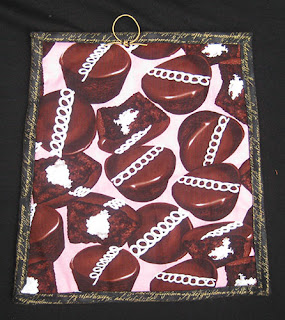- Low-pressure;
- Relaxing, especially between larger projects;
- An opportunity to experiment with new techniques;
- An opportunity to get fabrics out of your stash and into the world;
- And the result is something you can give as a gift! (Christmas/Chanukah: Six months away!)
Potholder 1 - Solid Scraps
Directions: Take a bunch of solid scraps; stitch them together. Quilt using your relatively new Handi-Quilter mini scallop ruler, just for practice. (Quilting with rulers is like learning to juggle, and requires infinite practice.)
Fill with two layers of batting (or one layer of regular cotton batting, and one layer of thermal batting, like Insul-Bright.) For backing, shop your stash until you find a fragment of home decor fabric that you never used because it was awkwardly cut:
When giftees ask why you put the pears in such an unusual position, pretend you did it on purpose and explain asymmetry.
Directions: Scour your stash or Internet to locate fragments of stunning giant vegetable fabric from Kaffe Fassett and his co-conspirators at gloriouscolor.com. This fabric was always (1) too nice to cut into, and (2) so distinctive that it takes over any project, and (3) Giant turnips? Cut it in large chunks, and combine with other fabrics if necessary.
On the back, plop down another piece from the Fassett collective that's been in the stash for too many years.I accidentally installed it upside-down. (I did that on purpose! Because, uh, asymmetry?)
Potholder 3 - Fruit & Cupcake Salad

Directions: Locate all your fruit fabrics, cut them into rectangles, and sew them into a trapezoidal top. If you don't have enough fruit fabrics, feel free to add vegetables (brussel sprouts, hot peppers), carbs (bread, pasta, pretzels, a fortune cookie), fats (avocados) and dairy (ice cream). This piece is so almost-healthy on the front that you can use something like this on the back:
Mmmmm good! What kind of potholders do you like to make?
































